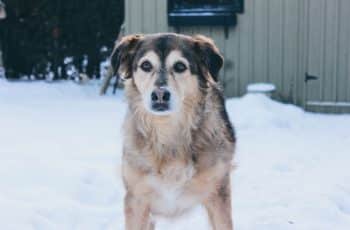Preparing your home and yard when a new puppy comes into your life is essential. Puppies are like little whirlwinds of curiosity and energy, exploring every nook and cranny of your home and yard. But with all that curiosity comes the potential for accidents and mishaps. So, how do you keep your new furball safe and sound? Well, you puppy-proof your home and yard, of course!
In this guide, we’ll share our list for puppy-proofing your home and yard to ensure your new puppy can safely romp and roam.
5 Proven Ways to Ensure a Puppy Safe Yard
1. Preventing Your Pup’s Great Escape: Fence Safety
Puppies love to explore. Imagine your little pup’s eyes filled with excitement as they spot a squirrel or anything of interest on the other side of your fence. Those adorable little buggers will try to fit into and through anything.
Make sure you don’t encourage the next Houdini of dogs, and check your fence for holes or gaps wide enough to fit through. Because if they fit, they will go through it. And don’t leave your puppy outside unattended. It doesn’t take them long to get into trouble.
2. Green Dangers: Identify Toxic Plants in Your Yard
You’d be surprised how many seemingly harmless plants can be toxic to your four-legged friend. Azaleas, lilies, and oleander can be a real hazard. Dwayne “The Rock” Johnson’s puppy Brutus died after eating a poisonous mushroom. So, stroll in your yard and ensure you’re not unintentionally growing a pet poison garden.

3. Keep Your Pup Away from Trash Temptations
Dogs are savvy when it comes to finding tasty morsels in the trash. What is our trash is their buffet. Don’t let them indulge in garbage gourmet. Secure your trash cans in a shed or fenced area. Or use dog-proof ones to keep your puppy from creating a mess.
4. Create a Safe Outdoor Haven with Pet-Friendly Landscaping
Consider using pet-friendly landscaping materials (fertilizers, pesticides, mulch, etc). You can have a lush yard and have it be safe for your puppy, too. And puppies love to chew on mulch and eat everything we don’t want them to.
If you must use potentially harmful chemicals, store those items in a secure building or shed. Save yourself (and your puppy!) the stress and heartache of having toxic products easily accessible.
5. Illuminate Safety: Outdoor Lighting for Your Puppy
Install motion-activated outdoor lighting to enhance visibility during nighttime bathroom breaks. Outdoor lighting will also scare away wild animals who might harm your puppy. Plus, it may keep you from accidentally stepping on something squishy.

8 Vital Home Puppy-Proofing Tips
6. Baby Gates: Create Safe Zones for Your Puppy
Baby gates can be used to block off rooms or areas your puppy shouldn’t roam freely. Use one at the top of the stairs until your puppy is used to the stairs and has grown a little. Baby gates will keep your puppy in the areas you want and out of any potentially troublesome places.
7. Shield Your Wires: Cord Safety for Teething Puppies
Puppies are teething machines. Their adult teeth come in around six to eight months, so they will look for things to chew on, like electrical cords. Use cord covers or tape to safeguard your wires. Trust us; it’s way better than a shocking experience for your pup.
Providing them with appropriate toys or bones to chew on during their teething stage is also good. If you find your puppy chewing on a wire, distract them with a bone or toy they can chew on, and give them lots of praise when they chew on it.
8. Lock Away Hazards: Safeguard Cleaning Supplies
Cleaning supplies contain very toxic chemicals to dogs. And since dogs can’t read the ingredients list to know what’s safe to eat and what’s not, it’s best to keep those supplies away from their curious reach.

9. Protect Pups: Medication & Vitamin Safety
Medications and vitamins can be enticing, even for humans. Gummy vitamins, anyone? I thought those were candy when I was a kid. And so will your puppy. Keep those items in the medicine cabinet out of your puppy’s wandering nose.
It’s important to share that information with guests, too. A friend’s dog ate all of her guests’ fish oil supplements. Her dog was ultimately okay, but he was very sick for several days. Her guest didn’t think to secure those supplements from that fantastic nose.
10. Puppy-Proofing Your Furniture: Rules and Covers
Consider setting rules about your puppy being on the furniture. If they’re allowed, invest in pet-proof covers to keep your couch looking new. Consider getting corner covers for any sharp-edged furniture. Think of your puppy like a toddler careening into everything.
See also

Keep your puppy off the couch until they are bigger. Their bones are fragile, and they could hurt themselves if they jump down from a sofa. It may not seem that far to you, but for them, it’s a great distance.

11. Prevent Trashy Adventures: Indoor Trash Can Safety
Just as you did outside, ensure your indoor trash cans are dog-proof. You don’t want your furry friend indulging in garbage delights. One idea is to install an under-the-counter mount for your trash can. Not only does it save kitchen floor space, but it keeps it from the roving mouths of little puppies.
12. A Distasteful Habit: Litter Box Safety
One of the world’s great mysteries is why dogs like to eat from the cat’s litter box and then come over and lick your face. It’s disgusting. And it can make them sick and cause intestinal issues if they consume a lot of litter with their “snacks.”
It’s best to ensure the cat box is in a place the puppy can’t access. A good place is the laundry room if it is big enough for the litter box. You can put a gate across the door to keep out that insatiable puppy appetite.

13. Design a Safe Haven: The Puppy Zone
Use the baby gates we mentioned before to create a puppy zone in your home with safe flooring, toys, and activities. This area will be where your puppy can play and explore without being watched constantly. Especially when you need to leave the house, ensuring your puppy has a safe space is essential for your peace of mind.
Consider crate training your puppy. A crate can be a controlled environment that is safe for your puppy. When your puppy is correctly crate-trained, the crate will become a place of comfort for your puppy.
Your Pup’s Paradise: A Safe Home and Yard
So, there you have it – a comprehensive guide to puppy-proofing your yard and home. With these tips, you’ll be well-prepared to keep your new furry family member safe and sound as they embark on their exciting journey of exploration. Remember, a little precaution goes a long way in ensuring your puppy’s safety and happiness.


